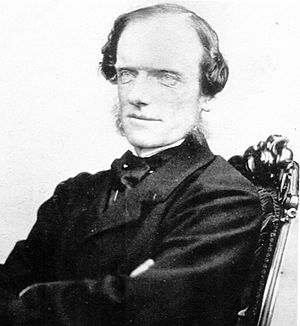John Robert Godley facts for kids
Quick facts for kids
John Robert Godley
|
|
|---|---|

Portrait of John Robert Godley
|
|
| Born | 29 May 1814 Dublin, Ireland
|
| Died | 29 November 1861 (aged 47) London, England
|
| Monuments | Godley Statue in Christchurch |
| Nationality | British |
| Alma mater | Christ Church, Oxford |
| Occupation | Colonial reformer |
| Employer | Canterbury Association |
| Known for | Founder of Canterbury |
| Spouse(s) | Charlotte Godley |
| Children | Arthur Godley, 1st Baron Kilbracken |
| Relatives | Denis Daly (grandfather) James Daly, 1st Baron Dunsandle and Clanconal (uncle) Robert Daly (uncle) Sir Morgan George Crofton, 3rd Baronet (uncle by marriage) A. D. Godley (nephew) Alexander Godley (nephew) Charles Griffith-Wynne (father-in-law) Charles Wynne (brother-in-law) Hugh Godley, 2nd Baron Kilbracken (grandson) |
John Robert Godley (born May 29, 1814 – died November 17, 1861) was an important British and Irish leader. He is known as the founder of Canterbury in New Zealand. Even though he only lived there for two years, his work helped create this important settlement.
Contents
Early Life
John Robert Godley was born in Dublin, Ireland. He was the oldest son of John Godley and Katherine Daly. His father was a wealthy landlord who owned large country estates in Ireland.
John Godley went to Harrow School and then to Christ Church, Oxford university. He studied classics and finished his degree in 1836. He was often sick, which stopped him from becoming a lawyer as he had planned.
Building a New Colony
After university, Godley traveled a lot in Ireland and North America. His journeys helped him form strong ideas about how to set up and manage new colonies. In 1843, he became the High Sheriff of Leitrim, a local government role. The next year, he became a Deputy Lieutenant and a Justice of the Peace, which meant he helped keep law and order.
In September 1846, he married Charlotte Griffith Wynne. In 1847, he tried to become a member of the UK parliament for Leitrim. However, he lost the election. Many people, especially Roman Catholic priests, were against his plan to send people to Canada to help with the Irish famine.
Around this time, Edward Gibbon Wakefield, who owned the New Zealand Company, asked Godley for help. Wakefield wanted Godley to start a new colony in New Zealand. This colony would follow the beliefs of the Church of England. Godley agreed to lead this new colony. His political connections were very helpful in getting money for the project.
The First Ships Arrive
Four years later, in April 1850, Godley and his family arrived in Port Cooper (now Lyttelton). Captain Joseph Thomas met them. He showed Godley the plans for three new towns and homes in Lyttelton.
In December 1850, a group of four ships arrived in Lyttelton. These ships were the Randolph, Cressy, Sir George Seymour, and Charlotte Jane. They carried settlers and supplies for the new colony.
Leading the Settlement
For the next two years, John Godley was the leader of the new settlement, which was named Christchurch. He worked with the Canterbury Association to change their rules for farming land. He wanted to make sure the colony could start well with a strong farming base.
Godley believed that the Canterbury Association's main job was to start Canterbury, not to control it. He thought the colony should be able to govern itself. In November 1852, a group of people asked Godley to run for the first election for Superintendent of the Canterbury Province. However, he said no.
Later Life and Legacy
Godley left Canterbury and returned to England in December 1852. At a special dinner held in his honor, Godley talked about how much progress Canterbury had made in such a short time.
In England, Godley wrote articles for newspapers. He mostly wrote about how British colonies should be able to govern themselves. This was a topic he cared deeply about. He also worked at the War Office, which managed the British army. There, he continued to argue for British colonies to have more control over their own affairs.
John Godley passed away on November 17, 1861, in London. The people of Christchurch put up a bronze statue of him in Cathedral Square in 1867. The artist Thomas Woolner designed it. The statue fell off its base during the February 2011 Christchurch earthquake.
Godley's only son was Sir Arthur Godley. His nephew was General Sir Alexander Godley, a commander in WWI.
The house built for Godley in Lyttelton was later taken down to make way for a building for the Plunket Society. When the Plunket building was demolished in 2012, archaeologists found the post holes of Godley's original house. They believe his two-story house had at least six rooms, which was quite large for an early colonial building.

